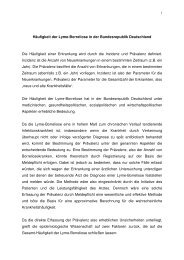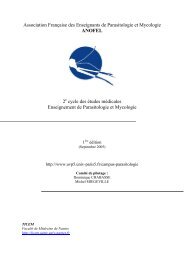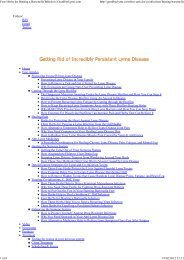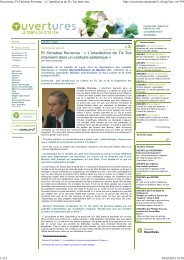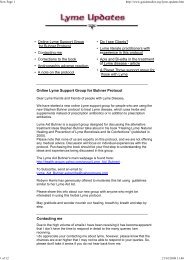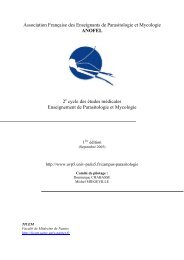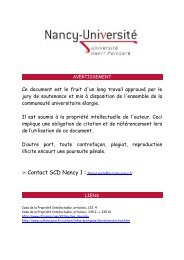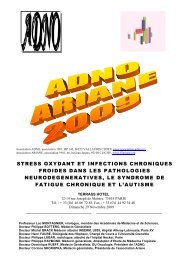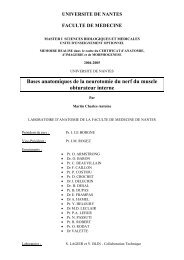Die Rolle des Europäischen Igels (Erinaceus europaeus) in der ...
Die Rolle des Europäischen Igels (Erinaceus europaeus) in der ...
Die Rolle des Europäischen Igels (Erinaceus europaeus) in der ...
Sie wollen auch ein ePaper? Erhöhen Sie die Reichweite Ihrer Titel.
YUMPU macht aus Druck-PDFs automatisch weboptimierte ePaper, die Google liebt.
Summary<br />
iii<br />
Summary<br />
Title: The role of the European hedgehog (<strong>Er<strong>in</strong>aceus</strong> <strong>europaeus</strong>) <strong>in</strong> the epidemiology of<br />
tick-borne diseases (Borrelia spp., Anaplasma spp., Rickettsia spp. and TBE-virus).<br />
Vector-borne pathogens circulate <strong>in</strong> nature between blood-suck<strong>in</strong>g arthropods and vertebrate<br />
hosts via a variety of transmission cycles through which they can also reach humans. Basic<br />
<strong>in</strong>vestigations on the pathogen-vector-host relationship are therefore necessary <strong>in</strong> or<strong>der</strong> to<br />
un<strong>der</strong>stand such a complex epidemiological situation.<br />
The work presented focuses on the role of hedgehogs, notably <strong>Er<strong>in</strong>aceus</strong> <strong>europaeus</strong>, <strong>in</strong> the<br />
circulation of tick-borne pathogens <strong>in</strong> Western and Central Europe. New data are presented<br />
particularly with regard to various genospecies of the Borrelia burgdorferi s.l. complex, but<br />
also <strong>in</strong>volv<strong>in</strong>g the epidemiology of Anaplasma species, Rickettsia species and tick-borne<br />
encephalitis (TBE) virus. For the molecular <strong>in</strong>vestigation of these pathogens, organs of<br />
dissected animals, as well as ticks (Ixo<strong>des</strong> hexagonus and Ixo<strong>des</strong> ric<strong>in</strong>us) removed from<br />
hedgehogs, were used. In addition blood samples from liv<strong>in</strong>g animals were tested by a<br />
modified ELISA and an immunoblot for specific antibodies aga<strong>in</strong>st Borrelia genospecies. The<br />
B. burgdorferi s.l. <strong>in</strong>vestigation was supplemented by xenodiagnosis on experimentally and<br />
naturally <strong>in</strong>fected hedgehogs.<br />
The results obta<strong>in</strong>ed demonstrate that hedgehogs play a significant role <strong>in</strong> the circulation of<br />
tick-borne pathogens with pathogenic potential for humans. The data acquired prove the<br />
reservoir potential of hedgehogs for certa<strong>in</strong> Borrelia genospecies (Borrelia afzelii, Borrelia<br />
bavariensis and Borrelia spielmanii). In particular juvenile hedgehogs or <strong>in</strong>dividuals with a<br />
reduced health status seem to be susceptible to <strong>in</strong>fection. In contrast to this, high IgG-titers<br />
aga<strong>in</strong>st specific Borrelia antigens and the low transmission rate from adult animals to ticks<br />
<strong>in</strong>dicate a reduction <strong>in</strong> the reservoir competence of hedgehogs presumably caused by adaptive<br />
immunity.<br />
Hedgehogs are also <strong>in</strong>volved <strong>in</strong> the circulation of Anaplasma phagocytophilum. My results<br />
show that they are susceptible to a specific “hedgehog variant”, but also to other genotypes.<br />
In a similar way, hedgehogs play a role <strong>in</strong> the epidemiology of Rickettsia species. Rickettsial<br />
DNA could be detected <strong>in</strong> a sk<strong>in</strong> sample of one animal, as well as <strong>in</strong> all life history stages of



